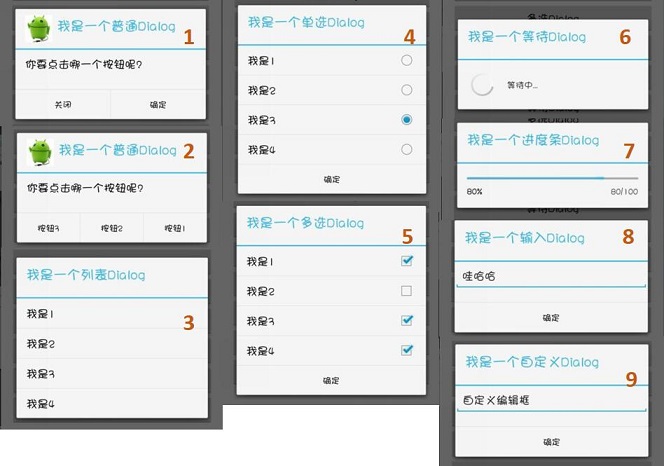推荐阅读
TensorFlow 2.0 (九) - 强化学习 70行代码实战 Policy Gradient
TensorFlow 2.0 (八) - 强化学习 DQN 玩转 gym Mountain Car
TensorFlow 2.0 (七) - 强化学习 Q-Learning 玩转 OpenAI gym
TensorFlow 2.0 (六) - 监督学习玩转 OpenAI gym game
TensorFlow 2.0 (五) - mnist手写数字识别(CNN卷积神经网络)
TensorFlow入门(四) - mnist手写数字识别(制作h5py训练集)
TensorFlow入门(三) - mnist手写数字识别(可视化训练)
TensorFlow入门(二) - mnist手写数字识别(模型保存加载)
TensorFlow入门(一) - mnist手写数字识别(网络搭建)
1.写在前面
- Android提供了丰富的
Dialog函数,本文介绍最常用的8种对话框的使用方法,包括普通(包含提示消息和按钮)、列表、单选、多选、等待、进度条、编辑、自定义等多种形式,将在第2部分介绍。 - 有时,我们希望在对话框创建或关闭时完成一些特定的功能,这需要
复写Dialog的create()、show()、dismiss()等方法,将在第3部分介绍。
2.代码示例

2.1 普通Dialog(图1与图2)
- 2个按钮
public class MainActivity extends Activity {
@Override
protected void onCreate(Bundle savedInstanceState) {
super.onCreate(savedInstanceState);
setContentView(R.layout.activity_main);
Button buttonNormal = (Button) findViewById(R.id.button_normal);
buttonNormal.setOnClickListener(new View.OnClickListener() {
@Override
public void onClick(View v) {
showNormalDialog();
}
});
}
private void showNormalDialog(){
/* @setIcon 设置对话框图标
* @setTitle 设置对话框标题
* @setMessage 设置对话框消息提示
* setXXX方法返回Dialog对象,因此可以链式设置属性
*/
final AlertDialog.Builder normalDialog =
new AlertDialog.Builder(MainActivity.this);
normalDialog.setIcon(R.drawable.icon_dialog);
normalDialog.setTitle("我是一个普通Dialog")
normalDialog.setMessage("你要点击哪一个按钮呢?");
normalDialog.setPositiveButton("确定",
new DialogInterface.OnClickListener() {
@Override
public void onClick(DialogInterface dialog, int which) {
//...To-do
}
});
normalDialog.setNegativeButton("关闭",
new DialogInterface.OnClickListener() {
@Override
public void onClick(DialogInterface dialog, int which) {
//...To-do
}
});
// 显示
normalDialog.show();
}
}
- 3个按钮
/* @setNeutralButton 设置中间的按钮
* 若只需一个按钮,仅设置 setPositiveButton 即可
*/
private void showMultiBtnDialog(){
AlertDialog.Builder normalDialog =
new AlertDialog.Builder(MainActivity.this);
normalDialog.setIcon(R.drawable.icon_dialog);
normalDialog.setTitle("我是一个普通Dialog").setMessage("你要点击哪一个按钮呢?");
normalDialog.setPositiveButton("按钮1",
new DialogInterface.OnClickListener() {
@Override
public void onClick(DialogInterface dialog, int which) {
// ...To-do
}
});
normalDialog.setNeutralButton("按钮2",
new DialogInterface.OnClickListener() {
@Override
public void onClick(DialogInterface dialog, int which) {
// ...To-do
}
});
normalDialog.setNegativeButton("按钮3", new DialogInterface.OnClickListener() {
@Override
public void onClick(DialogInterface dialog, int which) {
// ...To-do
}
});
// 创建实例并显示
normalDialog.show();
}
2.2 列表Dialog(图3)
private void showListDialog() {
final String[] items = { "我是1","我是2","我是3","我是4" };
AlertDialog.Builder listDialog =
new AlertDialog.Builder(MainActivity.this);
listDialog.setTitle("我是一个列表Dialog");
listDialog.setItems(items, new DialogInterface.OnClickListener() {
@Override
public void onClick(DialogInterface dialog, int which) {
// which 下标从0开始
// ...To-do
Toast.makeText(MainActivity.this,
"你点击了" + items[which],
Toast.LENGTH_SHORT).show();
}
});
listDialog.show();
}
2.3 单选Dialog(图4)
int yourChoice;
private void showSingleChoiceDialog(){
final String[] items = { "我是1","我是2","我是3","我是4" };
yourChoice = -1;
AlertDialog.Builder singleChoiceDialog =
new AlertDialog.Builder(MainActivity.this);
singleChoiceDialog.setTitle("我是一个单选Dialog");
// 第二个参数是默认选项,此处设置为0
singleChoiceDialog.setSingleChoiceItems(items, 0,
new DialogInterface.OnClickListener() {
@Override
public void onClick(DialogInterface dialog, int which) {
yourChoice = which;
}
});
singleChoiceDialog.setPositiveButton("确定",
new DialogInterface.OnClickListener() {
@Override
public void onClick(DialogInterface dialog, int which) {
if (yourChoice != -1) {
Toast.makeText(MainActivity.this,
"你选择了" + items[yourChoice],
Toast.LENGTH_SHORT).show();
}
}
});
singleChoiceDialog.show();
}
2.4 多选Dialog(图5)
ArrayList<Integer> yourChoices = new ArrayList<>();
private void showMultiChoiceDialog() {
final String[] items = { "我是1","我是2","我是3","我是4" };
// 设置默认选中的选项,全为false默认均未选中
final boolean initChoiceSets[]={false,false,false,false};
yourChoices.clear();
AlertDialog.Builder multiChoiceDialog =
new AlertDialog.Builder(MainActivity.this);
multiChoiceDialog.setTitle("我是一个多选Dialog");
multiChoiceDialog.setMultiChoiceItems(items, initChoiceSets,
new DialogInterface.OnMultiChoiceClickListener() {
@Override
public void onClick(DialogInterface dialog, int which,
boolean isChecked) {
if (isChecked) {
yourChoices.add(which);
} else {
yourChoices.remove(which);
}
}
});
multiChoiceDialog.setPositiveButton("确定",
new DialogInterface.OnClickListener() {
@Override
public void onClick(DialogInterface dialog, int which) {
int size = yourChoices.size();
String str = "";
for (int i = 0; i < size; i++) {
str += items[yourChoices.get(i)] + " ";
}
Toast.makeText(MainActivity.this,
"你选中了" + str,
Toast.LENGTH_SHORT).show();
}
});
multiChoiceDialog.show();
}
2.5 等待Dialog(图6)
private void showWaitingDialog() {
/* 等待Dialog具有屏蔽其他控件的交互能力
* @setCancelable 为使屏幕不可点击,设置为不可取消(false)
* 下载等事件完成后,主动调用函数关闭该Dialog
*/
ProgressDialog waitingDialog=
new ProgressDialog(MainActivity.this);
waitingDialog.setTitle("我是一个等待Dialog");
waitingDialog.setMessage("等待中...");
waitingDialog.setIndeterminate(true);
waitingDialog.setCancelable(false);
waitingDialog.show();
}
2.6 进度条Dialog(图7)
private void showProgressDialog() {
/* @setProgress 设置初始进度
* @setProgressStyle 设置样式(水平进度条)
* @setMax 设置进度最大值
*/
final int MAX_PROGRESS = 100;
final ProgressDialog progressDialog =
new ProgressDialog(MainActivity.this);
progressDialog.setProgress(0);
progressDialog.setTitle("我是一个进度条Dialog");
progressDialog.setProgressStyle(ProgressDialog.STYLE_HORIZONTAL);
progressDialog.setMax(MAX_PROGRESS);
progressDialog.show();
/* 模拟进度增加的过程
* 新开一个线程,每个100ms,进度增加1
*/
new Thread(new Runnable() {
@Override
public void run() {
int progress= 0;
while (progress < MAX_PROGRESS){
try {
Thread.sleep(100);
progress++;
progressDialog.setProgress(progress);
} catch (InterruptedException e){
e.printStackTrace();
}
}
// 进度达到最大值后,窗口消失
progressDialog.cancel();
}
}).start();
}
2.7 编辑Dialog(图8)
private void showInputDialog() {
/*@setView 装入一个EditView
*/
final EditText editText = new EditText(MainActivity.this);
AlertDialog.Builder inputDialog =
new AlertDialog.Builder(MainActivity.this);
inputDialog.setTitle("我是一个输入Dialog").setView(editText);
inputDialog.setPositiveButton("确定",
new DialogInterface.OnClickListener() {
@Override
public void onClick(DialogInterface dialog, int which) {
Toast.makeText(MainActivity.this,
editText.getText().toString(),
Toast.LENGTH_SHORT).show();
}
}).show();
}
2.8 自定义Dialog(图9)
<!-- res/layout/dialog_customize.xml-->
<!-- 自定义View -->
<LinearLayout xmlns:android="http://schemas.android.com/apk/res/android"
android:orientation="vertical"
android:layout_width="match_parent"
android:layout_height="match_parent">
<EditText
android:id="@+id/edit_text"
android:layout_width="match_parent"
android:layout_height="wrap_content"
/>
</LinearLayout>
private void showCustomizeDialog() {
/* @setView 装入自定义View ==> R.layout.dialog_customize
* 由于dialog_customize.xml只放置了一个EditView,因此和图8一样
* dialog_customize.xml可自定义更复杂的View
*/
AlertDialog.Builder customizeDialog =
new AlertDialog.Builder(MainActivity.this);
final View dialogView = LayoutInflater.from(MainActivity.this)
.inflate(R.layout.dialog_customize,null);
customizeDialog.setTitle("我是一个自定义Dialog");
customizeDialog.setView(dialogView);
customizeDialog.setPositiveButton("确定",
new DialogInterface.OnClickListener() {
@Override
public void onClick(DialogInterface dialog, int which) {
// 获取EditView中的输入内容
EditText edit_text =
(EditText) dialogView.findViewById(R.id.edit_text);
Toast.makeText(MainActivity.this,
edit_text.getText().toString(),
Toast.LENGTH_SHORT).show();
}
});
customizeDialog.show();
}
3.复写回调函数
/* 复写Builder的create和show函数,可以在Dialog显示前实现必要设置
* 例如初始化列表、默认选项等
* @create 第一次创建时调用
* @show 每次显示时调用
*/
private void showListDialog() {
final String[] items = { "我是1","我是2","我是3","我是4" };
AlertDialog.Builder listDialog =
new AlertDialog.Builder(MainActivity.this){
@Override
public AlertDialog create() {
items[0] = "我是No.1";
return super.create();
}
@Override
public AlertDialog show() {
items[1] = "我是No.2";
return super.show();
}
};
listDialog.setTitle("我是一个列表Dialog");
listDialog.setItems(items, new DialogInterface.OnClickListener() {
@Override
public void onClick(DialogInterface dialog, int which) {
// ...To-do
}
});
/* @setOnDismissListener Dialog销毁时调用
* @setOnCancelListener Dialog关闭时调用
*/
listDialog.setOnDismissListener(new DialogInterface.OnDismissListener() {
public void onDismiss(DialogInterface dialog) {
Toast.makeText(getApplicationContext(),
"Dialog被销毁了",
Toast.LENGTH_SHORT).show();
}
});
listDialog.show();
}

发表评论 取消回复